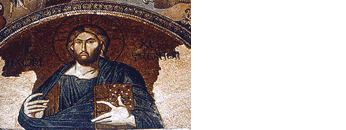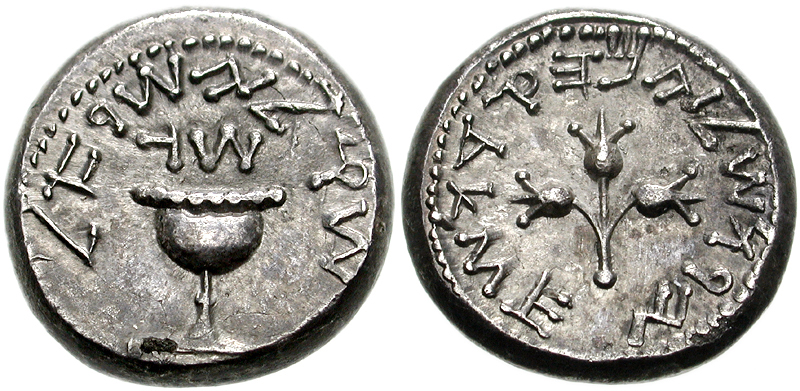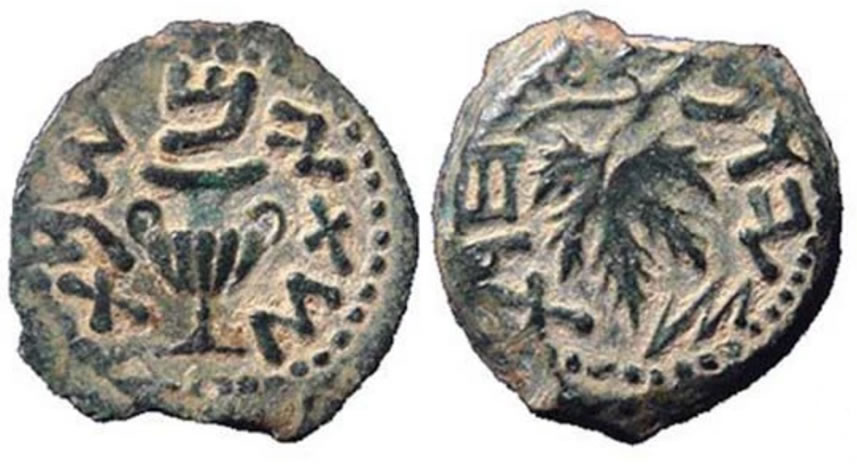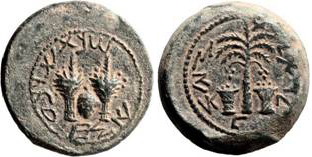
|
|
|
|
|
Artifact Analysis
|
|
|
|
- Coins of the First Jewish Revolt
-

The First Jewish Revolt (66-74 CE) entailed battles thoughout Palestine, the sieges of Masada and Jerusalem, the destruction of its Second Temple, and the rise of the victorious Roman general Vespasian and his son Titus as the new imperial dynasty in Rome (the Flavians). -
 Before the Jewish defeat, its rebel leaders minted coins for their nascent government and economy, and these coins bore the aspirational symbols of restoration they hoped for. The silver half-shekel above, from the second year of the revolt (68-69 CE), bears a cup on the obverse with the inscription "Shekel of Israel, Year 3," while the reverse has three budding pomegranates and the inscription "Jerusalem the Holy." The second coin to the right, from Masada, bears the imprint of a narrow-necked amphora on one side (with the inscription "Year Two") and a vine and tendril on the reverse (with the inscription "the freedom of Zion"). Before the Jewish defeat, its rebel leaders minted coins for their nascent government and economy, and these coins bore the aspirational symbols of restoration they hoped for. The silver half-shekel above, from the second year of the revolt (68-69 CE), bears a cup on the obverse with the inscription "Shekel of Israel, Year 3," while the reverse has three budding pomegranates and the inscription "Jerusalem the Holy." The second coin to the right, from Masada, bears the imprint of a narrow-necked amphora on one side (with the inscription "Year Two") and a vine and tendril on the reverse (with the inscription "the freedom of Zion"). -
 By the fourth year of the revolt, silver was less available, so later coins are made with bronze. On this coin of the fourth year, we see the symbols of the Pentecost pilgrimage festival, the lulav (bound branches of myrtle, palm and willow) and etrog (citron - like a lemon) on the obverse (left), with a palm tree and baskets on the reverse (right). By the fourth year of the revolt, silver was less available, so later coins are made with bronze. On this coin of the fourth year, we see the symbols of the Pentecost pilgrimage festival, the lulav (bound branches of myrtle, palm and willow) and etrog (citron - like a lemon) on the obverse (left), with a palm tree and baskets on the reverse (right).-
-
- Bibliography
-
- DeBloois, Nanci. "Coins in the New Testament." BYU Studies 36:3 (1997) 239-251.
-
- Hendin, David B., Nathan W. Bower and Sean G. Parham. "A Critical Examination of Two Undated Prutot of the First Jewish Revolt." Israel Numismatic Research 8 (2013) 73-87.
-
- Kadman, Leo. "A Coin Find at Masada." Israel Exploration Journal 7:1 (1957) 61-5.
-
- --------. "The Coins of the First Revolt." Congrès international de numismatique, Paris, 6-11 juillet, 1953, vol. 2, Actes (Paris: Commission internationale de numismatique, 1957) 239-48.
-
- --------. "The Dating of the Shekels." The Numismatist 62 (1949) 548-51.
-
- --------. "The Hebrew Coin Script: A Study in the Epigraphy of Ancient Jewish Coins." Israel Exploration Journal 4:3/4 (1954) 150-69.
-
- --------. "The Problem of the Shekels." Seaby's Coin and Medal Bulletin 10 (1949) 480-83.
-
- Kindler, Arieh. "Restruck Coins of the First Revolt." Bulletin of the Israel Exploration Society 17 (1952) 65-6. [Hebrew].
-
- Meshorer, Yaʿakov. "The Coins of Masada." In Masada: The Yigael Yadin Excavations 1963–1965: Final Reports, I: The Aramaic and Hebrew Ostraca and Jar Inscriptions; The Coins of Masada (ed. Yaʿakov Meshorer, Joseph Naveh and Yigael Yadin; Jerusalem: Israel Exploration Society, 1989) 71-132, plates 61-81. [see especially pp. 73-6, 101-121 and pls. 66-72, 74]
-
- Reich, Ronny. "Women and Men at Masada: Some Anthropological Observations Based on the Small Finds (Coins, Spindles)." Zeitschrift des Deutschen Palästina-Vereins 117:2 (2001) 149-163.
-
- Reifenberg, Adolf. Ancient Jewish Coins, 2nd ed. Jerusalem: Ruben Mass, 1947. (see p. 58, No. 147a and plates X–XI)
-
- --------. Israel's History in Coins from the Maccabees to the Roman Conquest. London: East and West Library, 1953. (see p. 13)
-
- Roth, Cecil. "The Historical Implications of the Jewish Coinage of the First Revolt." Israel Exploration Journal 12:1 (1962) 33-46.
-
- Sarfatti, Gad B. "Notes on the Inscriptions on Some Jewish Coins and Seals." Israel Exploration Journal 27:4 (1977) 204-206.
-
-
-
|
|
|
|
|
